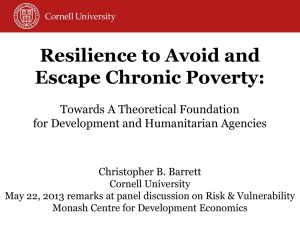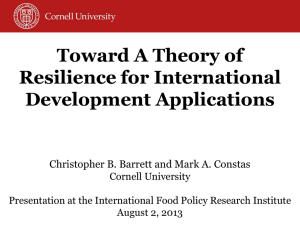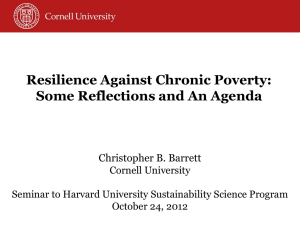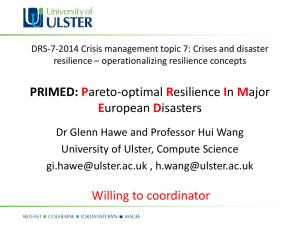Resilience to Avoid and Escape Chronic Poverty
advertisement
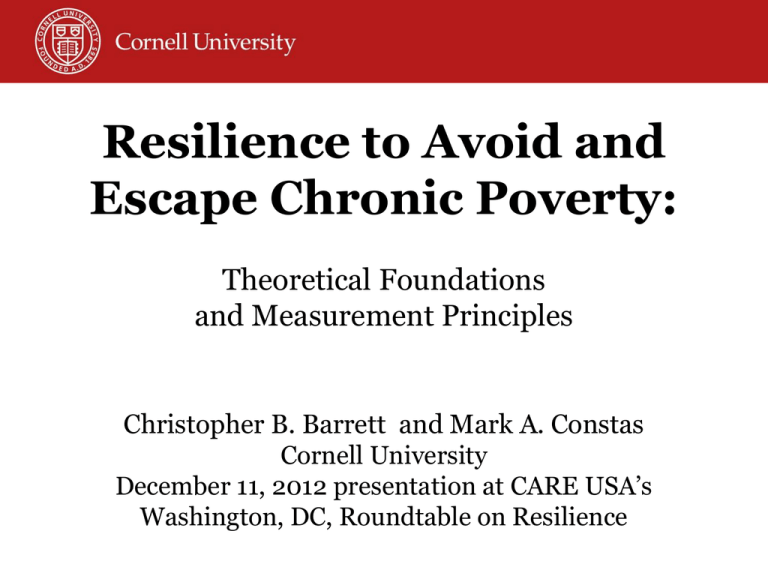
Resilience to Avoid and Escape Chronic Poverty: Theoretical Foundations and Measurement Principles Christopher B. Barrett and Mark A. Constas Cornell University December 11, 2012 presentation at CARE USA’s Washington, DC, Roundtable on Resilience Prologue Activity – past few years Three main reasons for increased activity around the concept of development resilience 1. Pronounced Risks Increasing exposure to risk related to natural disasters, climate, food markets, macroeconomic shocks, political violence, etc. 2. Bridging the Divide Recurring crises have highlighted the importance of aligning humanitarian and development objectives 3. Ecological/biophysical Factors Growing consensus that development work must be connected to pressing environmental concerns Prologue Activity – past few years Work concerned with the poverty dynamics is not new, but the recent activity in development has used resilience as a common platform on which: • A range of initiatives, strategic plans, and funded program for humanitarian response and development assistance have been based • Broad participation from government agencies, INGOs, multilateral organizations and foundations has been structured and promoted • Many white papers, reports, workshops, conferences, newly established centers, working groups, high profile events, articles, blogs, and tweet… have been based Prologue Activity – past few years Prologue Activity – past ten days December 3, 2012 USAID Press Release Prologue Activity – past ten days December 3, 2012 World Vision Press Release Prologue Activity – past ten days December 6, 2012 AGIR-Sahel, High Level Meeting in Burkina Faso http://www.neurope.eu/article/eu-will-inject-500-million-help-food-crisis-sahel Prologue Hope October 3, 2012 Prologue Hope November 7, 2012 http://ec.europa.eu/echo/policies/res ilience/resilience_en.htm Prologue More Hope November 19, 2012 Prologue ….and Creeping Doubt http://www.irinnews.org/Report/96549/AID-POLICY-Resistingresilience-reassessing-the-new-mantra http://blog.usaid.gov/2012/12/does-the-new-resilience-policy-havestaying-power/ Prologue ….and Creeping Doubt October 25, 2012 http://www.irinnews.org/Report/96549/AID-POLICY-Resistingresilience-reassessing-the-new-mantra November 14, 2012 http://www.ids.ac.uk/news/can-resilience-bring-something-newto-poverty-alleviation I. Framing the Problem What do we have and what is needed? What we have: • Much activity/enthusiasm around the resilience concept • Some activity is rhetorical, some is strategic/policy oriented, some is conceptual, and some is programmatic • An opportunity to bridge between humanitarian response and development assistance strategies What we need: • Theory to integrate programmatic efforts and analytical approaches connected to mitigation, buffering, coping, and adaptation • Theory-driven measurement to evaluate progress • Body of empirical results based on theory-driven measures I. Framing the Problem Call for Theory of Resilience Theory is important because it: • Serves as a conceptual tool to help build coherence for wide range of variables and across a selection of programmatic approaches • Directs attention to the importance of explanations that identify not just if something worked but also why something worked –thereby pushing us to identify causal mechanisms Highlighting the need for explanatory knowledge of resilience , a recent ODI Humanitarian Policy Brief offered the following: “…the frameworks [of resilience cannot assist in answering critical questions, such as what is it that makes people more or less sensitive to crisis, because these dimensions are left as unexplained ‘black boxes’ ”(Levine et al., 2012, p. 2). from Levine, S, Pain, A., Bailey, S., and Fan, L, 2012. The Relevance of Resilience? ODI, Humanitarian Policy Brief 49 II. Toward a Theory Resilience foregrounds risk in well-being dynamics: Shocks that disrupt lives and livelihoods: the single greatest cause of descents into chronic poverty (Krishna, etc.) Uninsured risk of catastrophic loss (stressors): a key structural reason for poverty traps/chronic poverty We seek to bridge the ecological/engineering literatures on resilience with the social science literatures on risk and poverty traps in order to: - advance a theory of resilience against chronic poverty - tease out measurement principles appropriate to that theory II. Toward a Theory Resilience of whom to what? Subject of interest – quality of life, roughly Sen’s ‘capabilities’. This implies a focus on individuals’ (and groups’) well-being within a system, not the state of a system itself. System has instrumental rather than intrinsic importance. Focus further on minimizing the human experience of chronic poverty. We therefore focus on places with high rates of chronic poverty and risk exposure. Do not focus on a specific source of risk b/c problem is uninsured exposure to a wide array of stressors (ex ante risk) and shocks (ex post, adverse realizations) to which resilience implies adaptability while staying non-poor. II. Toward a Theory We need to adapt ecological/engineering theory to the development/humanitarian response context. As used in ecology or engineering – e.g., “the ability of the system to maintain its identity in the face of internal change and external shocks and disturbances” (Cumming et al. 2005 Ecosystems, p. 976) – resilience is not necessarily desirable for populations trapped in chronic poverty. Their objective may be escape from – not persistence in -- their present state of existence. To be useful for development policy, we need resilience to be a normative property, to be orderable – and preferably decomposable (in FGT sense) – in order to offer a useful metric to gauge performance and guide policy/programming. II. Toward a Theory Concept of Resilience for Development Development resilience represents the likelihood over time of a person, household or other unit not being poor in the face of various stressors and in the wake of myriad shocks. If and only if that likelihood is high, then the unit is resilient. Key Elements: Standards of living: Focus on avoiding/escaping poverty Effects of stressors: Uninsured risk influences dynamic incentives Response to shocks: Temporary setbacks vs. permanent descents Dynamical system vs. static representations of standards of living II. Toward a Theory Well-Being Dynamics Figure 1: Nonlinear expected well-being dynamics with multiple stable states Humanitarian emergency zone E[future] capabilities Death Death T1 Chronic poverty zone Non-poor zone T2 Current capabilities Noncontroversially: NPZ >> CPZ >> HEZ Those in CPZ or HEZ are chronically poor in expectation The CEF reflects indiv/collective behaviors (agency/power) w/n system II. Toward a Theory Well-Being Dynamics Figure 1: Nonlinear expected well-being dynamics with multiple stable states The humanitarian ambition is to keep people from falling into HEZ … offers foundation of a rightsbased approach to resilience. E[future] capabilities Humanitarian emergency zone The development ambition is to move people into the non-poor zone and keep them there. Death Death Chronic poverty zone Non-poor zone Current capabilities For the current non-poor, seek ‘resilience’ against shocks in the ecological sense: no shift to either of the lower, less desirable zones. But for the current poor, those in HEZ/CPZ, the objective is productive disruption, to shift states. Asymmetry is therefore a fundamental property of resilience against chronic poverty. Thus stability ≠ resilience. II. Toward a Theory Well-Being Dynamics A Utopian, asymmetric vision of well-being dynamics: Figure 2: Desired expected well-being dynamics with multiple stable states E[future] capabilities Humanitarian emergency zone Egalitarian option Death Death Chronic poverty zone Non-poor zone Current capabilities ‘Egalitarian option’: engineering concept applies - return to initial state. ‘Random walk w/safety net option’: implies perfect downward resilience at NPZ/CPZ boundary … but zero resilience upward or w/n NPZ. II. Toward a Theory Well-Being Dynamics Explicitly incorporate risk, move from CEF to CTD: Figure 3: Nonlinear well-being dynamics with conditional transition distributions Humanitarian emergency zone Future capabilities Death Death Chronic poverty zone Non-poor zone Current capabilities Note: The shape of the CTD affects the shape of the CEF Transitory shocks (- or +) can have persistent effects Risk may be partly endogenous to system state II. Toward a Theory Well-Being Dynamics Feedback between sub-systems can be crucial If we represent the preceding conditional transitions as: Wt+1=g(Wt|Rt,εt) where W is welfare, R is the state of the natural resource, and ε is an exogenous stochastic driver Then simply introducing feedback between R and W (e.g., range conditions depend on herd size/stocking rate) Rt+1=h(Rt|Wt,εt) or allowing for drift in ε (e.g., due to climate change) means the underlying CTD changes over time. Then the resilience of the underlying resource base becomes instrumentally important to resilience against chronic poverty. II. Toward a Theory Well-Being Dynamics Coupled human and natural systems dynamics E[future] capabilities E[future] natural resource state ? Current capabilities Current natural resource state Note: - Ecological resilience links to human resilience through reciprocal causality in coupled human/natural dynamics - Many candidate relationships make prediction difficult at best II. Toward a Theory Programming implications Objective: min likelihood people fall into HEZ/CPZ Three options: 1) Shift people’s current state – i.e., move initial state rightward. Ex: asset transfers: cash, education, land. 2) Alter CTDs directly (and thereby ∆ system too). Ex: social protection - EGS, insurance, improved police protection, drought-resistant animal/plant genetics. 3) Change the underlying system structure – institutions/ technologies – induces ∆ in behaviors and CTDs. Prob: multi-scalar reinforcement – ‘fractal poverty traps’ Systems thinking becomes important to reveal the structure – and possible intervention points – behind univariate dynamics. II. Toward a Theory Programming implications The importance of social institutional arrangements “A tale of two widows” And would the widower’s dynamic = the widow’s? Mid-point summary • We make no claim that this is THE definitive theory of resilience against chronic poverty. We merely claim that such theory(ies) is sorely needed to help shape the accelerating programming around resilience. This is one candidate. • Such theory needs to explicitly link risk, poverty and supporting natural resources in an explicitly dynamic context. • Theory becomes especially important as a bedrock for measurement for M&E and prioritization. III. Measurement General Measurement Principles – not specific to resilience but important across all measurement situations 1. Gender-based analysis/gender equity and focus on women and mothers 2. Distinction between chronically poor and transiently poor 3. Measurement of non-market goods both subjective and objective elements 4. Measurement of observables and latent variables, leading to constructs/factors 5. Technical properties of measures –reliability and validity – and rigorous analysis of the origins and effects of measurement error • • • Ravallion, M. 1996. Issues in measuring and modeling poverty. Economic Journal, 106 (438), 1328-1343. Krishnakamur, J. 2007. Going Beyond Functionings to capabilities: an econometric model to explain and estimate capabilities, Journal of Human Development. 8 (1), 39-63 2010 UN Resolution 64/289 (49-50 ); HDR GDI, GEM; Guidance from various sources UNEGEEW, UNSD, DESA, ECOSOC III. Measurement Resilience Specific Measurement Principles A set of theory-based measurement principles for resilience that has operational merit should: • Specify what needs to be measured to produce data needed to test and advance interventions and policies • Substantive functions of measurement • Describe how data should be handled to draw inferences about interventions and policies • Analytical functions of measurement III. Measurement Principles for Resilience Measurement Substantive Principles Focus on what needs to be measured to understand and predict resilience Analytical Principles Focus on the properties of responses so that patterns in resilience data may be identified Operational and Procedural Details • • • • Constructs Mediators Indicators/variables Measurement tools • • • • Sampling design Causal structure Modeling procedures Types of inferences III. Measurement Substantive principles 1. Poverty Focus Principle Importance of using poverty as the main indicator of the resilience • Population variation guideline • Multidimensionality and weighting guideline 2. Intensive Risk Assessment Principle Importance of detailed risk assessment that sensitive both conspicuous and subtle stressors • Multidimensionality-intertemporal guideline • Cumulative and interactive guideline III. Measurement Substantive Principles 3. Response Heterogeneity Principle Importance of response pattern variations and the impact of institutional forces • Intra/inter unit variations guideline • Institutional variations guideline 4. Contextual Influences Principle Importance of conditions and mediators that influence effects of outcomes • Socio-ecological guideline • Causal-mediators guideline III. Measurement Substantive Principles Summary of Substantive Principles The substantive principles for measurement specify that measurement tools should: • Focus poverty in a manner that is sensitive to population variations and reflect the multidimensionality of well being • Measure stressors/shocks that reflect multidimensionalintertemporal (weighted) qualities with sensitivity to cumulative and interactive effects • Measure the range of responses that account for the ability or inability to avoid remaining or falling into poverty and consider variations within and between housholds/units • Measure the impact of institutions and governance structures that facilitate or hinder • Measure the influence of socio-ecological contexts as mediators III. Measurement Analytical Principles 5. State Dependent Dynamics Principle The importance of state dependence and measurement of paths over time • Initial-States Guideline • Trajectories Guideline 6. Stochastic Processes Principles The importance of distinguishing between stochastic and structural risk factors • Stochastic-structural differentiation guideline • Structured conditional risk guideline III. Measurement Analytical Principles 7. Threshold Sensitivity Principle Importance of measures that are sensitive to tipping points, abrupt descents and impacts on well-being • Hierarchical options guideline • Indirect reflections guideline 8. Cross-Scale Interactions Principle Importance of measures taken across scales with attention to interactions across levels • Multi-scalar assessment guideline • Multi-level guideline III. Measurement Analytical Principles Summary of Analytical Principles The analytical principles for measurement specify that measurement tools should: • Be sensitive to initial conditions, not just as points but as paths or trajectories • Distinguish between stochastic and structural causes of poverty • Employ analytic approaches that are flexible so that the capacity to detect effects will not be hindered by strong assumptions (e.g., homoskedasticity) • Be able to detect tipping points and multiple equlibria that affect resilience • Assess effects across scales and as nested interdependencies (e.g., individuals, within households, within communities) III. Measurement Analytical Principles Summary of Analytical Principles The analytical principles for measurement specify that measurement tools should: • Be sensitive to initial conditions, not just as points but as paths or trajectories • Distinguish between stochastic and structural causes of poverty • Employ analytic approaches that are flexible so that the capacity to detect effects will not be hindered by strong assumptions (e.g., homoskedasticity) • Be able to detect tipping points and multiple equlibria that affect resilience • Assess effects across scales and as nested interdependencies (e.g., individuals, within households, within communities) III. Measurement Summary Measurement Principles for Development Resilience Substantive Principles Analytical Principles 1. Poverty Focus Principle o Population variation guideline o Multidimensionality and weighting guideline 2. Intensive Risk Assessment Principle o Multidimensional -intertemporal guideline o Cumulative and interaction guideline 3. Response Heterogeneity Principle o Household variation guideline o Institutional capacities guideline 4. Contextual Influences Principle o Causal impacts guideline o Multiple contexts guideline 5. State Dependent Dynamics Principle o Initial states guideline o Trajectories guideline 6. Stochastic Process Principle o Stochastic dominance guideline o Stochastic-Structural guideline 7. Threshold Sensitivity Principle o Bifurcation threshold guideline o Dynamic thresholds guideline 8. Cross-Scale Interactions o Proximal-distal effects guideline o Nested-effects guideline IV. Summary Resilience is a popular buzzword now. But little precision in its use, either theoretically, methodologically or empirically. Aim to help facilitate rigorous, precise use of the concept to help identify how best to avoid and escape chronic poverty. This will require advances in theory, measurement and empirical work in many different contexts and over time. We start by advancing a conceptual theory of resilience and measurement principles that derive from that theory. Much to do in all areas … a massive research agenda, especially as agencies begin using resilience as a programming principle. Thank you Thank you for your time, interest and comments!


